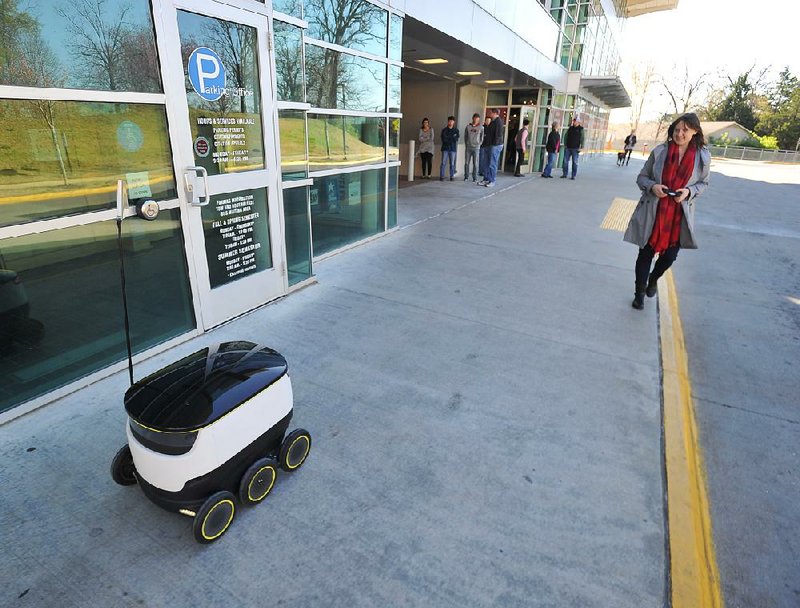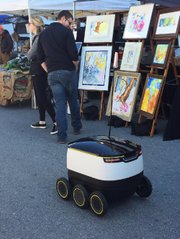FAYETTEVILLE -- The six-wheeled robot rolled its way through the crowd last weekend, mingling with humans at Fayetteville's Farmers Market.
Allan Martinson and Helen Kaarlep, both with Estonia-based Starship Technologies, stood close by and kept watch as shoppers noticed the contraption, which resembled a cooler on wheels. Some took a quick glance and kept walking. Others stopped and stared. A few wondered aloud: "What is that?"
If Martinson, Kaarlep and the rest of Starship Technologies are successful, it won't be long before everyone knows the answer. The company is in the process of testing a semiautonomous delivery robot, one Starship believes is the future of parcel, grocery and restaurant deliveries.
"Our goal is to totally disrupt how we do our shopping and deliver packages," said Martinson, Starship's chief operating officer. "The average American family spends about one hour per day driving to shop and back. It's time-consuming. It's inefficient. It's one hour we'd like to give back."
The delivery robot, also referred to as a ground drone, has been traveling sidewalks in Northwest Arkansas for the past week as part of the company's United States testing program. Starship Technologies, which also is evaluating the robot in countries like the United Kingdom, Germany and Estonia, has partnered with the McMillon Family Retail Innovation and Technology Lab at the University of Arkansas to continue to evaluate the social acceptance and performance of the vehicle.
Martinson said the robot has traveled more than 1,500 miles in tests in five or six countries since the co-founders of Skype -- Ahti Heinla and Janus Friis -- introduced the device last year. The goal is creating a safe, environmentally friendly way to complete deliveries for a lower cost.
Martinson said hundreds of businesses have inquired about the robot since it was introduced.
"We never expected this amount of interest," Martinson said.
The University of Arkansas became involved when Susan Sedberry, managing director of the McMillon Family Retail Innovation and Technology Lab, was at Wal-Mart's 415c Lab for a meeting. Sedberry said Wal-Mart officials encountered the robot when it appeared at a trade show and scheduled a conference call with S̶t̶a̶r̶s̶h̶i̶p̶ ̶E̶n̶t̶e̶r̶p̶r̶i̶s̶e̶s̶ Starship Technologies* to learn more.
Sedberry was invited to listen in and, after hearing the company had not yet tested the robot in the United States, extended an invitation to visit Arkansas.
"I said, 'How many hills do you have in Estonia?" Sedberry said. "They said, 'It's pretty flat.' I said, 'I would love to be your U.S. command center and test on the hills of the Ozarks because if ever there was to be environmental testing on an autonomous vehicle I think I've got the perfect location.'"
Kaarlep, head of testing and operations at Starship, admitted the company didn't know much about Arkansas. In fact, company officials had to look for the state on a map. But it didn't take long after arriving to realize the terrain would be a good test for the device.
The delivery robot weighs 20 pounds, travels about 4 mph and can carry roughly 20 pounds of cargo. It's not intended for long distances. The idea is for customers to order items to be delivered through a mobile app and for the robot to complete trips within 30 minutes, at a cost that is 10 to 15 times lower than the normal delivery rates.
The robot is designed to operate autonomously 99 percent of the time, using GPS, sensors and cameras to navigate sidewalks to its destination. If assistance is needed, the robot can turn to an operator monitoring the device at a command center. It has a microphone as well, which will allow operators to inform anyone with bad intentions they're being filmed and authorities can be notified.
"It's not a self-driving car. It's a semiautonomous vehicle," Kaarlep said. "If you want to build a completely self-driving vehicle that means you would have to spend years and billions of dollars. But if you can outsource some of the decision-making to humans who can make split-second decisions based on everything, then you can go to market and make sure it's safe and secure faster."
John Kent, director of the supply-chain management research center at the Walton College of Business, believes the technology is more proof drone deliveries are becoming closer to reality. Kent said 18 months ago students were almost laughing at him about the idea of having drones deliver packages, but he is now holding 30-minute conversations about it in his classes.
"It's not quite a reality, but it's getting so close that people have accepted it's going to be a reality," Kent said. "And this literally puts our feet a little bit more on the ground in reality. If we're going to be delivering to doorsteps with a drone it's more likely going to be this than the aerial drone first."
Martinson and Kaarlep had to guide the robot with a remote during its initial testing in Arkansas. It was unable to operate autonomously because the sidewalks and pathways had not yet been mapped.
Martinson said the most important objective is measuring social acceptance of the device. He said tests in other locations around the world produced some unexpected results: Roughly 80 percent to 85 percent of people who cross paths with the robot don't pay any attention.
That wasn't the case when it traveled around downtown Fayetteville earlier this month.
In fact, S̶t̶a̶r̶s̶h̶i̶p̶ ̶E̶n̶t̶e̶r̶p̶r̶i̶s̶e̶s̶ Starship Technologies* and the University of Arkansas team welcomed the attention by placing a bowl of candy inside to attract children and other onlookers. It gave them a chance to explain their mission.
"We haven't really received much resistance," Kaarlep said. "You either ignore it or ask questions about what it is and what it does. Sometimes they make really interesting comments like, 'Can it carry my baby? What does it eat?' Somebody has tried to feed it a banana."
The robot is scheduled to be at the McMillon technology lab, which is named after Wal-Mart Stores Inc. Chief Executive Officer Doug McMillon and his family, a little longer before moving on for more tests this summer. University officials are hoping it returns later this summer and, if it does, plan to test the robot on a number of deliveries from textbooks to groceries.
It's no surprise Wal-Mart will be paying attention.
"We're always evaluating and watching new technologies that can help customers save time and money," a Wal-Mart spokesman said. "Our 415c Lab has a close relationship with this team at the U of A and we will be interested in the results of these tests."
SundayMonday Business on 04/10/2016
CORRECTION: Starship Technologies, an Estonia-based company, was misidentified in two references in this story about its semi-autonomous delivery robot.

